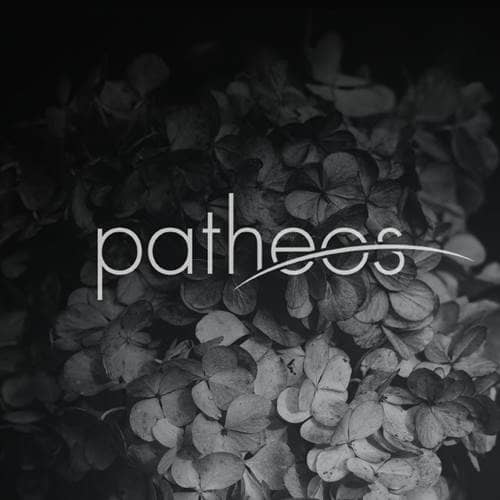- Trending:
- Pope Leo Xiv
- |
- Israel
- |
- Trump
- |
- Social Justice
- |
- Peace
- |
- Love
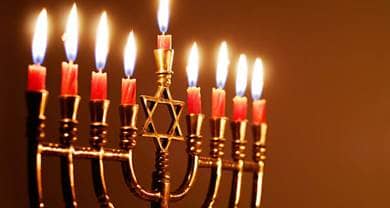
RELIGION LIBRARY
Judaism
Symbolism
Since biblical times, when the Israelite religion was forged as a resolutely anti-pagan faith that strenuously rejected all physical representations of the deity and commanded the destruction of any idolatrous icons and altars dedicated to the worship of "foreign gods," Judaism has remained a strongly iconoclast faith. As a result, one of the few areas in human creativity where there was, before the modern period, almost no Jewish contribution, has been the plastic arts. Even during the Renaissance, when there was an unprecedented surge of Jewish interest in almost all of the sciences and humanities, from astronomy and geometry to history, rhetoric, and music, Jews did not participate at all in the great artistic revival of the period.
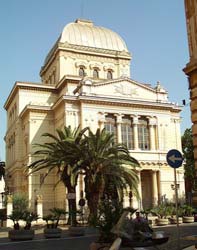 For this same reason, traditional synagogues have historically been almost entirely devoid of the great religious art, from statues to frescos and stained-glass windows, typically found in the great Roman Catholic and Orthodox churches. While the curtains covering the Holy Ark are beautifully embroidered, the art on them remains abstract; and while synagogue windows are occasionally color-stained, they eschew any specific representations from the natural world.
For this same reason, traditional synagogues have historically been almost entirely devoid of the great religious art, from statues to frescos and stained-glass windows, typically found in the great Roman Catholic and Orthodox churches. While the curtains covering the Holy Ark are beautifully embroidered, the art on them remains abstract; and while synagogue windows are occasionally color-stained, they eschew any specific representations from the natural world.
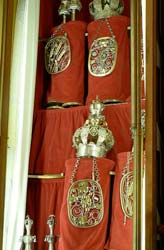 To the extent that traditional Judaism did create objects of art, these were limited to decorative versions of ritual objects—highly embroidered mantels, as well as silver crowns and breastplates, used to cover and adorn Torah scrolls; beautifully, but usually abstractly, painted seats for special occasions, like the one on which a baby was held during circumcision; intricately designed silver wine beakers for use at Shabbat and festival meals; and elaborately crafted silver items (gold was avoided due to its association with the biblical episode of the idolatrous worship of the golden calf) for religious use.
To the extent that traditional Judaism did create objects of art, these were limited to decorative versions of ritual objects—highly embroidered mantels, as well as silver crowns and breastplates, used to cover and adorn Torah scrolls; beautifully, but usually abstractly, painted seats for special occasions, like the one on which a baby was held during circumcision; intricately designed silver wine beakers for use at Shabbat and festival meals; and elaborately crafted silver items (gold was avoided due to its association with the biblical episode of the idolatrous worship of the golden calf) for religious use.
The aversion to artistic images, particularly those depicting human figures, even extends to the area in which Judaism has been, proportional to the numbers of its adherents, by far the most productive and prolific of the world's religious communities: namely, book publishing. Jewish books from the pre-modern period only rarely contain any illustrations beyond those absolutely necessary for clarifying points in Jewish law, such as simple diagrams. (Some notable exceptions include a small number of celebrated medieval illuminated manuscripts of the Bible and illustrated editions of the Pesach Haggadah.) So, while the "people of the book," as Jews have so widely been known, 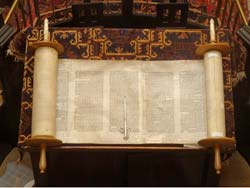 have produced a vast and impressive library of religious and philosophical texts, they are aesthetically primitive and do not begin to approach Christian artistic, calligraphic, and decorative achievements. Nor does the special Hebrew calligraphy used to write Torah scrolls, phylacteries, and mezuzahs approach either the beauty or ornate complexity of its Muslim counterpart, to say nothing of the latter's use in the history of Islamic architecture and decorative arts.
have produced a vast and impressive library of religious and philosophical texts, they are aesthetically primitive and do not begin to approach Christian artistic, calligraphic, and decorative achievements. Nor does the special Hebrew calligraphy used to write Torah scrolls, phylacteries, and mezuzahs approach either the beauty or ornate complexity of its Muslim counterpart, to say nothing of the latter's use in the history of Islamic architecture and decorative arts.
 This artistic and symbolic paucity notwithstanding, there are a few central symbols of Judaism whose display is almost ubiquitous in Jewish life. The best known of these is the Magen David, most commonly known in English as the Star of David, but more properly translated as the Shield of David. While its origins are to this day debated by historians and while it is almost certainly not the ancient icon that it purports to be, it has been, since the High Middle Ages, a very popular image that recalls the height of the Kingdom of David (c. 1000 B.C.E.) for whose restoration Jews pray on a daily basis.
This artistic and symbolic paucity notwithstanding, there are a few central symbols of Judaism whose display is almost ubiquitous in Jewish life. The best known of these is the Magen David, most commonly known in English as the Star of David, but more properly translated as the Shield of David. While its origins are to this day debated by historians and while it is almost certainly not the ancient icon that it purports to be, it has been, since the High Middle Ages, a very popular image that recalls the height of the Kingdom of David (c. 1000 B.C.E.) for whose restoration Jews pray on a daily basis.  While its use on the front exterior wall, or on the roof, of synagogues has been common for almost two millennia, the adoption of this symbol for the flag of modern day State of Israel has made the Shield of David the most recognizable and universal symbol of Jews and Judaism in the modern era. The Star of David is also the most common symbol used on Jewish tombstones and other memorial tablets, where it is commonly engraved in the identical space occupied by the cross on Christian memorial stones.
While its use on the front exterior wall, or on the roof, of synagogues has been common for almost two millennia, the adoption of this symbol for the flag of modern day State of Israel has made the Shield of David the most recognizable and universal symbol of Jews and Judaism in the modern era. The Star of David is also the most common symbol used on Jewish tombstones and other memorial tablets, where it is commonly engraved in the identical space occupied by the cross on Christian memorial stones.
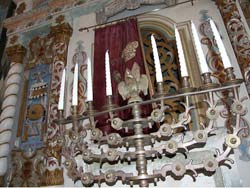 Two other decorative symbols commonly found in Jewish houses of worship and are the seven-pronged Menorah, or candelabra, and an image of the tablets of law (i.e., the Ten Commandments) brought down by Moses from Mount Sinai. Many synagogues feature these above their exterior entrance and above the Holy Ark containing the Torah scrolls. Their shape alone conveys the memory of the unique moment of God's self-revelation to the Children of Israel on the Holy Mountain. Finally, the chart-of-arms of the Twelve Tribes of Ancient Israel is a common symbol found in Jewish institutions, although only rarely within the synagogue sanctuary.
Two other decorative symbols commonly found in Jewish houses of worship and are the seven-pronged Menorah, or candelabra, and an image of the tablets of law (i.e., the Ten Commandments) brought down by Moses from Mount Sinai. Many synagogues feature these above their exterior entrance and above the Holy Ark containing the Torah scrolls. Their shape alone conveys the memory of the unique moment of God's self-revelation to the Children of Israel on the Holy Mountain. Finally, the chart-of-arms of the Twelve Tribes of Ancient Israel is a common symbol found in Jewish institutions, although only rarely within the synagogue sanctuary. 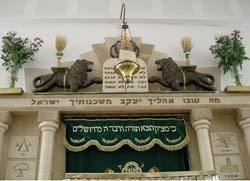 The recollection of these tribes has a similar effect, or at least intent, of upholding the Jews' collective anticipation of the ingathering of the lost exiles to the Land of Israel and the reconstitution of the glorious days of the Kingdom of David, during which time all twelve tribes, ten of whom were "lost" in the 8th century B.C.E., dwelled securely in the Holy Land.
The recollection of these tribes has a similar effect, or at least intent, of upholding the Jews' collective anticipation of the ingathering of the lost exiles to the Land of Israel and the reconstitution of the glorious days of the Kingdom of David, during which time all twelve tribes, ten of whom were "lost" in the 8th century B.C.E., dwelled securely in the Holy Land.
Study Questions:
1. How did Judaism's understanding of paganism shape its use of symbolism?
2. When Jewish people did create art, how was it manifested?
3. When did the Star of David first appear as a Jewish symbol?
4. What Jewish symbols are most often found in homes? What do they represent?








